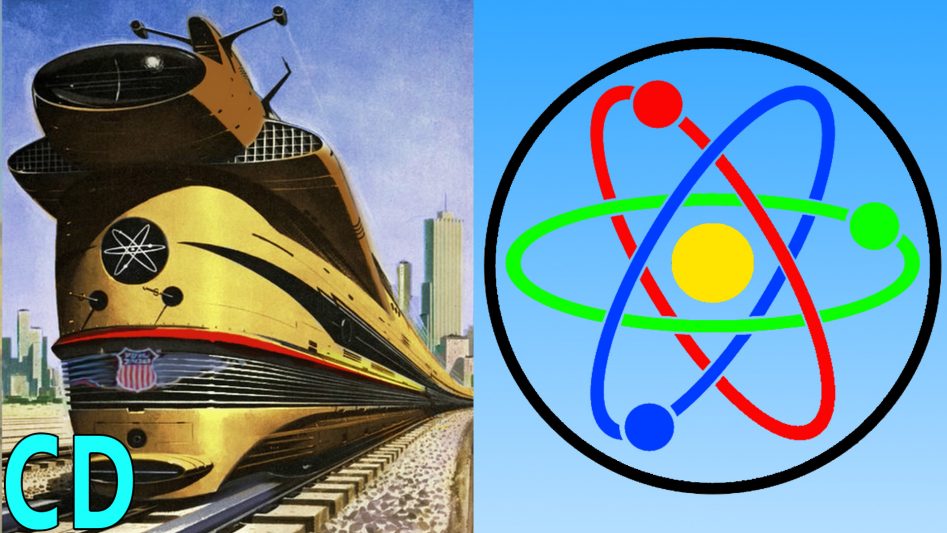To quote L.P Hartleys 1953 book “The GoBetween”, “The past is a different country, they do things differently there”.
That’s definitely something that could be applied our attitude to the newly discovered atomic power in the late 1940’s and 50s.
Within just a few years after the first atomic bombs had been dropped on Japan, it seemed as though the atom would the cure all our all our energy needs with power “too cheap to meter” as was once quoted.
Whilst ships and submarines of the leading navies went nuclear, companies put forward ideas for atomic powered planes, trains and yes, indeed automobiles.
The first idea of using a radioactive power source for a car, in this case, Radium, dates back to 1903 and in 1937 further analysis of the concept thought that it would need 50 tonnes of shielding to protect the driver. But with the development of the small self-contained reactors for ships and submarines in the 1950’s, the idea of atomic cars was back on the table.
In 1958 Ford unveiled a Uranium powered concept car called, with a typically 1950’s futuristic name, the Ford Nucleon. In essence, it was a scaled down submarine reactor in the back of the car which would heat stored water into high-pressure stream which then drove two turbines, one which provided the power to the wheels and the other which drove an electrical generator.
Ford engineers anticipated that it would have a range of about 5000 miles before you would need to nip into your local Ford dealers for the uranium core to be swapped out for a new one.
The passenger compartment was situated over the front wheels allowing the bulk of the reactor and the heavy shielding to be more centrally placed and to keep you as far as possible from the reactor.
As was the optimism of the 1950’s and the naivety of the general public, it was believed that nuclear power would eventually replace petrol power in the future.
Something which doesn’t bear thinking about if imagine that a car crash could turn into a major nuclear incident.
Ford only ever made scale models of the Nucleon as they anticipated the miniaturisation of the reactors and lighter shielding materials. As these didn’t appear and with the public’s increased awareness of radiation and nuclear waste, the project was dropped and the models ended up in the Henry Ford Museum in Dearborn, Michigan.
Now if you thought that the Ford Nucleon was a bit far fetched just look at the French Simca Fulga, a 1958 concept car designed by Robert Opron. This was meant to show how cars might look in the year 2000, powered by a nuclear reactor with voice control and guided by radar and an autopilot which communicated with a control tower. At over speeds of 150 km/h two of the wheels would retract and it would balance on the remaining two with the aid of gyroscopes.
Also in France in 1957-58, the Arbel Symétric was proposed with either a gas generator or 40Kw nuclear reactor called the “Genestatom”. This would use radioactive cartridges made from nuclear waste. However, the French government disapproved of the use of nuclear fuel in cars and the development stopped.
Of all the land-based forms of transport, Trains were the most likely candidates to be nuclear powered, especially those travelling across large areas where electrification had not been done.
In the US, a nuclear-powered locomotive called the X-12 was put forward in a design study for the Association of American Railroads and several other companies by Dr Lyle Borst, one of the early members of the Manhattan project, which created the first Atomic bomb.
The X-12 would use liquid Uranium 235 oxide dissolved in sulfuric acid in a 3ft by 1ft container, surrounded by 200 tonnes of shielding. The reactor would then create the steam to power the turbines to drive four electrical generators.
These would create the 7000hp of electricity to power the motors. This was the same as a four loco unit each having 1750hp but would only need to the refuelled once a year, although it would have cost about twice the price of a four loco unit.
The whole locomotive would be 160 ft long and weigh 360 tonnes and would have an articulated rear section where all the cooling radiators would be placed.
But the cost of developing such locomotive without government subsidies and the highly enriched uranium 235 together with the huge cost of liability insurance in case of an accident made the X-12 uneconomic and it was not pursued by any of the train companies.
However, in 1950’s Soviet Russia, money was not the issue as it was in the US. In places like the north, Far east and central Asian deserts it was thought that electrification of newly built railway lines was not advisable at the time.
So in 1956, the Ministry of Transport for the USSR came up with a plan to make supersized nuclear-powered trains which would run on tracks up to three times the width of normal tracks.
The train could be used in areas where there were little in the way of supplies or infrastructure to support a normal railway and whilst it was stopped it could also serve as a small PowerStation to generate electricity and hot water for heating for weeks or months if required in remote places.
The train would use the super-sized tracks to accommodate the extra weight of all the radiation shielding. But whilst the might be enough to protect the drivers and passengers in front and behind the loco, the sides and underneath might still irradiate the environment.
The other problem is that the infrastructure like embankments, bridges, tunnels would have to be enlarged for the extra wide track over thousands of miles in some of the world’s coldest and toughest environments, this and the radiation problem put an end to the supersized Soviet nuclear train.
And so finally we come to planes, the idea for nuclear-powered planes in the 1950’s was that bombers carrying atomic bombs could be kept on permanent standby flying around the arctic circle for days or weeks at a time without the need to refuel and ready to attack at a moments notice.
Both the US and the Soviets worked on nuclear-powered planes.
There were two methods of making a nuclear-powered jet engine. One was simple and light this was the direct cycle engine. In place of a combustion chamber, the air comes into the jet, then is directed through the reactor core, this would cool the core but heat up the air which would be directed back to the jet exhaust as thrust. The problem with this method is that if the shielding was not good enough the air could become irradiated, so you would leave a trail of radiation behind the plane.
The second method used an indirect way of linking the air via a heat exchanger to the reactor so that so the air could not get irradiated but this meant a lot heavier plumbing and complexity which would make the plane heavier and slower and more susceptible to attack.
The biggest problems both the US and the Soviets faced with nuclear-powered planes was getting enough thrust from the engines and the extra weight of the shielding to protect the crew.
Although no actual flights were made by nuclear-powered engines in the US, they did use a highly modified Convair B-36 Peacemaker with a real reactor to test a distributed method of radiation shielding.
By the time President Kennedy was elected in 1961 the direct cycle engine developed by General electric was finally regularly making high levels of thrust under nuclear power in ground-based tests.
Work on what was to be the WS-125 long-range nuclear bomber had continued from 1954 to 1961 but when new intelligence from the U-2 spy plane and satellites showed that the Soviets had much less in the way of bombers than the US thought and the Russian nuclear-powered bombers just didn’t exist, so Kennedy scrapped the WS-125 bomber program in favour of more missile and submarine development.
But after the fall of communism in Russia in the late 1980’s it was revealed that the Soviets had actually flown a nuclear-powered version of the Tu-95 “Bear” long-range bomber 40 times between 1961 and 1969.
Under pressure in believing that the Americans were close to creating a nuclear bomber, the Soviets flew tests with direct cycle nuclear-powered engines. However, the engines were inefficient and spewed radiation in to the air. The plane also had to fly no shielding to protect the crew otherwise it would have been too heavy to take off.
Although it worked, within 3 years some of the crew had died due to the radiation exposure on the test flights and this was the real Achilles heel of nuclear-powered planes, while the engines may work, the shielding is still a major problem.
Today we could, with the new technologies that have arisen since the 1950’s, build much smaller and safer nuclear reactors. We have already done it for spacecraft like the Voyager probes of the 1970s which are still going deep in space and for landers like the Mars Curiosity rover of 2012.
Already, nuclear-powered surveillance drones that don’t need crew or heavy shielding and that could fly for weeks or months and nuclear powered trains in Russia are being proposed once more.




Comments
Please add me to your subscription list (I can’t find where to do it…)